Vicente Traver Calzada was born on 13 Mars 1945 in Burriana, Spanish province of Castellón. His father, Vicente, was a house painter and the little Vicente played with paintings and brushes from an early age.
After the Primary School and the combination of the Secondary School with the study of the painting with Ramón Catalán, he began the drawing studies in 1962 in the School of Arts and Trades of Castellón and from 1963 to 1968 he does the degree of Painting, Engraving and Teaching in the High School of Fine Arts of San Carlos in Valencia, coinciding with the forced participation in the university military service in Montejaque during three consecutive summers (1966,67,68).
When he finishes this degree with the National Final-Year Prize, he began the Sculpture degree in the High School of Fine Arts of San Fernando in Madrid, moving again to the High School of Fine Arts of San Carlos in Valencia because of the political disturbs and students movements that don’t allow the normal developing of the lessons in 1968 in Madrid. He obtains the Víctor de Plata to the Professional Merits and the Cross of Alfonso X el Sabio.
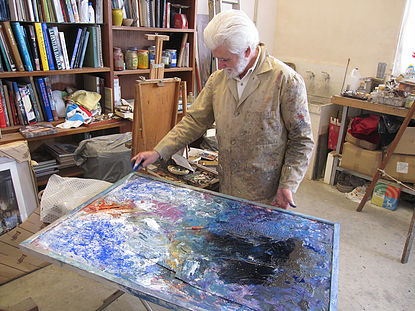 Traver Calzada in his studio
Traver Calzada in his studio
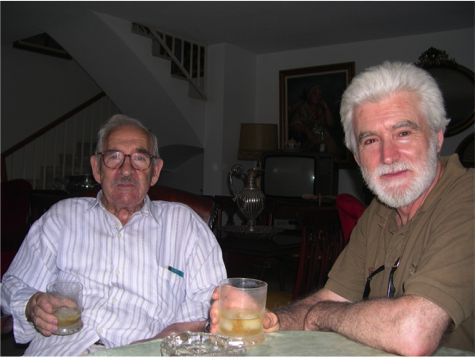 Traver Calzada with Ramón Catalán
Traver Calzada with Ramón Catalán
Although he realises pedagogic courses and obtains a grant of the Ministery of Education and Science to prepare a chair in the university, working as a teaching assistant in the subjects of Drawing and Chalcographic Engraving in the Escuela de Bellas Artes in Valencia, Traver Calzada decides fully engagin in the artistic creation and extends his studies in Paris, reciving a grant from the Castellblanch Art Foundation, and in Rome, from the Italian Foreign Affairs Ministry to do studies about mural painting.
He obtains many awards and recognitions as the Ist Prize of Drawing, the award of Engraving of the General Management of Fine Arts, the gold medal in the National Exposition of Segorbe, the silver medal in the II Art Week of Burriana, the Ist prize of Universitary Art of Valencia, the Ist Prize of Painting “Sport in art” of Valencia and the bronze medal of the Sagunto Savings Bank (Caja de Ahorros) and more.
In 1970 takes up permanent residence and studio in Burriana engaging in the study and activity of painter, sculptor and engraver, and some years later he got married with Asunción, a mathematics professor. Around this time, he founds the first Municipal School of Art in Burriana, today called the Municipal Centre of Culture Rafel Martí de Viciana.
He does several exhibitions all over Spain (Madrid, Oviedo, Valencia, castellón, etc.) and abroad ( Paris, Monaco, Japan, Mexico, Italy, etc.) and his work is exposed in many countries (Museum of Mina of Egypt, Hispanic Society of New York, private colecctions in United Kingdom, France, Italy, Monaco, United Stas, etc.). In this years he does the sculptural triptych Tombatossals to the wall of the main house of Castellón and the bust of the historian Viciana to Burriana.
In1989 Traver Calzada is studied in the doctoral thesis of Wencenslao Rambla converted in a book named Traver Calzada, el problema de la relidad (Traver Calzada, the problem of reality), where Traver Calzada’s works are analysed according to the most current image theories.
In 1992 he does the retable of the Pilgrimage to the Basilica of Lledó of Castellón, that shows the pilgrimage of Castellón and surround the 1940 Porcar’s retable. In 1995 the Rotary Club of Burriana orders to Traver Calzada the bronze bust of the cardinal Tarancón and the following year he the altarpiece of the Church of Saint John the Baptist of Alcalá de Xivert where he shows the beheading of Saint John the Baptist and the meeting between St. Elizabeth and the Virgin Mary in a oval above it.
A year later he takes part in a collective exhibition of Bancaixa in Castellón “9 engravers interpret Ausiàs march” where several artists make an engraving based on a diferent poem of the valencian poet, with the later edition of a portfolio of lithographs.
In 1998 due to the series of exhibitions in Castellón, Valencia and Alicante of the Fundation Bancaixa, he edits the book Traver Calzada, Pintura, Dibujo, Grabado (Traver Calzada, Painting, Drawing, Engraving) with a general catalogue of his works and texts by his daughter Paula and the historian Antonio Gascó.
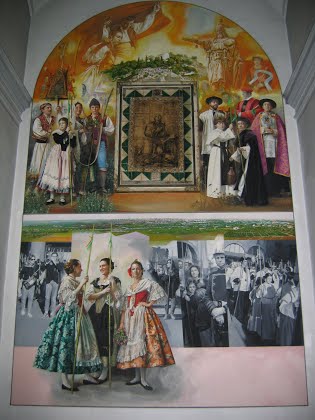 Retable of the Pilgrimage, in the Basilica of the Lledó in Castellón
Retable of the Pilgrimage, in the Basilica of the Lledó in Castellón
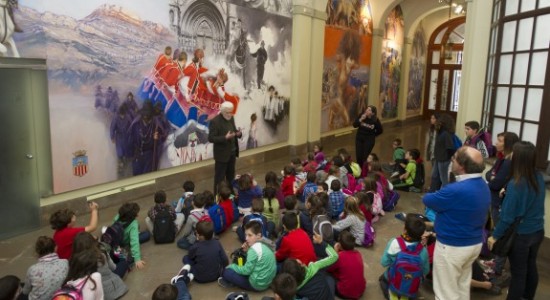 Traver Calzada in a scholar guided visit to the Murals of the Diputación of Castellón
Traver Calzada in a scholar guided visit to the Murals of the Diputación of Castellón
From 2001 to 2010 Traver Calzada makes the 10 murals that nowadays decorates the Hall of the Diputación Provincial of Castellón, with subjets based on decisive moments of the Castellón’s history, customs and folklore, the most representative monuments, legends and future projects, and this Hall is converted in a reference point of the most complete visual landscape of the province of Castellón.
At the same time that Traver Calzada finishes these murals, a book named Los murales de la Diputación de Castellón de Traver Calzada (by Antonio Gascó, 2010) is edited and its presentation was accompanied with by a concert of works of Paula Traver Navarro. Since then, a large number of guided visites to these murals are made by schools, associations and so on where the artist is often present.
In 2004 he did the inaugural exhibition of the Auditori and Palau of Congressos of Castelló, and because of this event a book named Armonías quebradas by Antonio Gascó was edited, and in 2007 he painted the Portrait of the Royal Family and The Pope Benedict XVI, commanded by the Genaralitat Valenciana as a result of the visit of the Pope to Valencia in the V World Meeting of Families in 2006. This portrait, inaugurated with the presence of the Queen Sofia, is considered as the firts painting that represents Joseph Ratzinger as a Pope.
The 25 septembre of 2011, the bishop of Segorbe-Castellón, Casimiro López Llorente, inaugures in the parochial church fo Saint John the Baptist in Cabanes two paintings of Traver Calzada, one of them about the Beheading of Saint John the Baptist, to the vestry, and the other one, The disciples of Emmaus to the Communion chapel.
The 7 of Octobre of this year, Traver Calzada is awarded the Prize of the Plastic Arts of Radio Castlellón of the Ser Station in the VIII Gala of Prizes Radio Castellón Ser Sation (in the photograph, the first on the right).
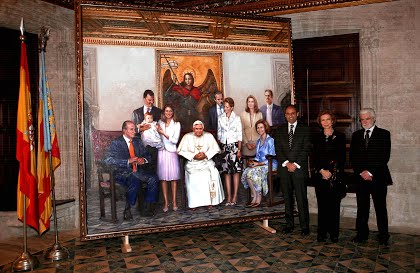 Traver Calzada with the Queen Sofía and the former president of the Generalitat Valenciana, in the inauguration of the Portrait of the Royal Family with the Pope Benedict XVI, as a result of the visit of the Pope to Valencia in the V World Meeting of Families
Traver Calzada with the Queen Sofía and the former president of the Generalitat Valenciana, in the inauguration of the Portrait of the Royal Family with the Pope Benedict XVI, as a result of the visit of the Pope to Valencia in the V World Meeting of Families
The 25 septembre of 2011, the bishop of Segorbe-Castellón, Casimiro López Llorente, inaugures in the parochial church fo Saint John the Baptist in Cabanes two paintings of Traver Calzada, one of them about the Beheading of Saint John the Baptist, to the vestry, and the other one, The disciples of Emmaus to the Communion chapel.
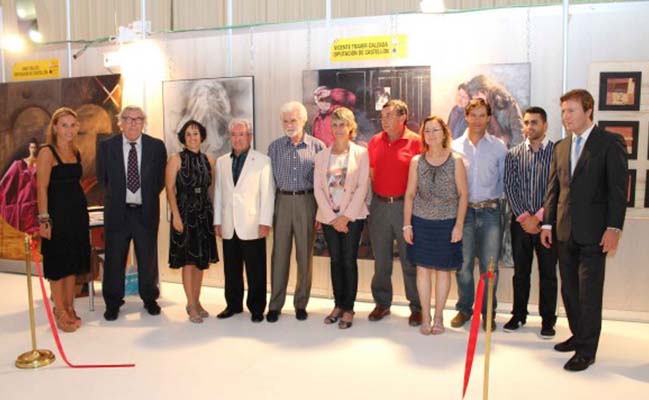 Inauguration of Marina d’Or IV Week
Inauguration of Marina d’Or IV Week
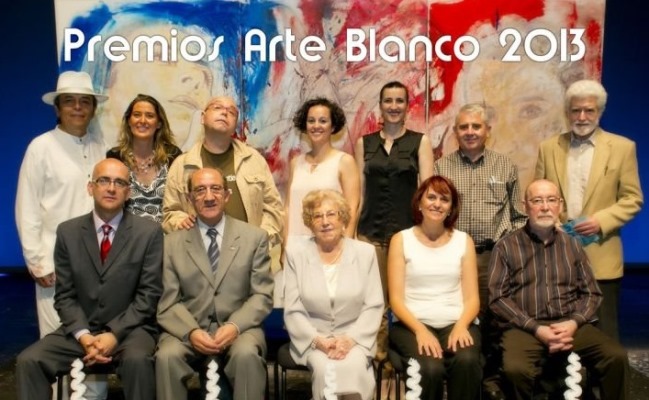 Prizes White Art 2013
Prizes White Art 2013
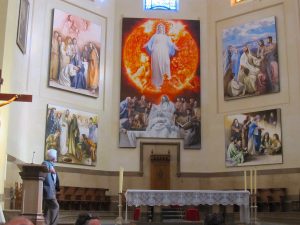
High Altarpiece Altar of the Cocathedral of Castellón
On December 2015 Traver Calzada he hangs out the two first altarpieces of large dimensions that illuminate the high altar of the concathedral of Saint Mary of Castellón dedicated to the Dormition of the Virgin and the Assumption of the Virgin, which belong to a pictorical suite composed by 8 retables. This same year he majes a triptych to the parish church of Bartolomé and Saint James of Nules, commanded on the occasion of a exhumation of priests, formed by a lying Christ, the portrait of these priests and another board that serves as a background to the sculpture of the Sacred Hearth. To the same church hangs out in 2016 the Last Supper, retable scrupulously documented that reflects the moment of the sacred agape from a historical viewpoint.
On 2017 he adds two pictures more to the Hight Altarpiece: Mary mother of the Church and Here are your mother and brothers, and en February 2019 two more: The Cana Wedding and The Child Jesus lost and found in the Temple with the Doctors of the Law.
On October 2019 the Diputación makes the exhibition Chronicle of the High Altarpiece of the Cocathedral of Castellón by Traver Calzada, with the publishing of a book Crónica del Altar Mayor de la Concatedral de Castellón de Traver Calzada (written by Antonio José Gascó Siro) and the video-documentary El retablo de la concatedral de Santa María de Castelló de Traver Calzada (by Paula Traver Navarro).
Regarding to the technique, it is important the use of the oil paintings, tempera painting, encaustic and engraving (he makes the dossier Sleghts with five etchings based on his own paintings, the series of Ofelia, Apse, Menina, etc.) and it is important too his known reputation as a portraitist.
His works are represented in the Hispanic Society of Nwe York, the Museum San Pío V of Valencia, the Museum of Modern Art of the Alhambra of Granada, the Museum of Contemporary Art of Villafamés, the Museum of Mina in Egypt, the Palace of the Diputación of Castellón, the Palace of the Diputación of Valencia, the Palace of the Generalitat of Valencia, the city council of Castellón, the Collection of Bancaixa, the Caja Rural and city council of Burriana, etc. and in many occasions, national and foreign art collections.
He has ilustrate books as La Historia de Burriana (The history of Burriana), Historia de la Farmacopea Valenciana (The history of the Valencian Pharmacopoeia) by P. Vernia, Ofelia by Rosa Mª Vilaroig, Burriana en la Piel (Burriana in the skin) by José Felix Escudero, Tombatossals by Pascual Tirado, Crónica de Castellón (Cronicles fo Castellón) by Antonio Gascó, etc. and his works have been commented by critical and art theoreticians as V. Aguilera Cerni, Román de la Calle, J. Garnería, R. Prats, E. L. Chavarri, P. Patuel, Manuel Godoy, Manuel Tarancón Fandos, Rosalía Torrent, Manuel Borja-Villel, Raúl Chavarri, F. Garín, etc.
Especially attentive to the evolution of the painter have been the studies and reviews of the academic Antonio Gascó (Historia de la Pintura de Castellón (History of the Painting in Castellón)).
Traver Calzada participates in the documentary Cinco artistas y un tombet (Five artists and a tombet) (https://www.youtube.com/watch?v=EMU_UrhnVwo) and in many interviews of radio and TV ( as El faro de los solitarios (The lighthouse of the solitaires)).
Cinco artistas y un tombet


